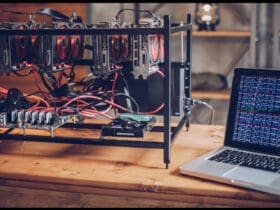This article covers the Best Proof-of-Work Coins Still Profitable for mining in 2025. With increasing network difficulty and climbing energy pricing, mining certain PoW cryptocurrencies remains very profitable.
We will consider the most profitable coins ranging from Bitcoin to the newer coins Ergo and Ravencoin, and explain their characteristics and advantages to help beginner and veteran miners alike understand why these coins are still competitive.
Key Points & Best Proof-of-Work Coins Still Profitable
| Cryptocurrency | Key Points |
|---|---|
| Bitcoin (BTC) | The first and most valuable PoW coin, offering high market value and global adoption. Mining requires specialized ASIC hardware and faces significant competition. |
| Monero (XMR) | A privacy-focused coin with untraceable transactions. ASIC-resistant, making it accessible for CPU and GPU miners. |
| Litecoin (LTC) | Often referred to as “digital silver,” Litecoin offers faster block generation times and uses the Scrypt algorithm, which is more GPU-friendly than Bitcoin’s SHA-256. |
| Zcash (ZEC) | A privacy coin built from Bitcoin’s code, offering shielded transactions. Supports both GPU and ASIC mining. |
| Dogecoin (DOGE) | Originally a meme coin, Dogecoin has developed a loyal community and robust mining ecosystem. Uses the Scrypt algorithm, making it easier to mine than Bitcoin. |
| Dash (DASH) | Focuses on speed and privacy with features like InstantSend and PrivateSend. Uses the X11 algorithm, allowing for GPU mining. |
| DigiByte (DGB) | A high-speed, highly secure blockchain with multiple mining algorithms, offering opportunities for both ASIC and GPU miners. |
| Ravencoin (RVN) | Designed for asset transfer and tokenization, Ravencoin uses the KawPow algorithm, which is optimized for GPU mining. |
| Kadena (KDA) | A scalable PoW blockchain with a unique braided chain architecture. Mining requires ASIC hardware. |
| Ergo (ERG) | A smart contract platform with a focus on efficiency and scalability. Uses the Autolykos algorithm, which is ASIC-resistant and suitable for GPU mining. |
10 Best Proof-of-Work Coins Still Profitable
1. Bitcoin (BTC)
Bitcoin still leads the field as the most powerful and secure proof-of-work cryptocurrency. No matter the expensive ASIC hardware and exorbitant energy requirements
It is still worthwhile for Bitcoin miners to operate on an industrial scale, provided they have access to cheap electricity.

Given its market cap, institutional adoption, and scarcity, it is a safe long-term investment. The recent halving in 2024 reduces the block reward to 3.125 BTC, increasing competition, but also the value of BTC.
Smaller miners can access the market through pools. Its decentralization attracts the most Bitcoin. Its profitability depends on the efficiency of the operations and the most liquidity balances it on the Bitcoin network.
Features Bitcoin (BTC)
Market Leader: First to be recognized as a cryptocurrency and holds the highest market capitalization.
Security: Network security is guaranteed with a high degree of decentralization and has power.
Mining Requirements: Requires ASIC miners. Mining is costly, competitive, and consumes a lot of power.
Cold Storage: Considered the “digital gold” and a long-term investment, it can be used to hedge with stores of value.
2. Monero (XMR)
Monero is the go-to option for privacy-centric users and miners. It utilizes the RandomX algorithm, which is optimized for CPU mining, so you can mine Monero without high-end equipment.
Monero is 100% anonymous which attracts users who need privacy. Monero provides decentralized network structure and complete ASIC mining resistance, which is beneficial for mining fairness.

Home miners can expect good profitability due to low hardware costs and decent block rewards. Continuously evolving technology along with supportive communities provides sustained ecosystem longevity.
Monero is highly profitable for solo miners, or miners with low-spec equipment, due to consistent, in-demand, privacy-preserving applications.
Features Monero (XMR)
Focus on Privacy: Transactions become untraceable with the combination of stealth addresses and ring signatures.
Not ASIC Dependant: Anyone can mine it as the RandomX algorithm is supportive of both CPU and GPU.
Decentralization: No centralization or control exists in mining as there is diverse mining hardware.
Communicative Community: Developers consistently issue releases with high focus on maintaining security and privacy in the network.
3. Litecoin (LTC)
Litecoin is frequently referred to as Bitcoin’s silver. Unlike Bitcoin, Litecoin uses the Scrypt algorithm which enables both ASIC and GPU mining. Litecoin’s security and profitability is further enhanced through merged mining with Dogecoin.
Litecoin’s quicker block generation times, which are 2.5 minutes, and low transaction costs make it a viable candidate for everyday payments.

Litecoin’s upgrades, including the implementation of MimbleWimble for privacy and the addition of features, have kept it relevant.
Especially when mining Dogecoin, mining Litecoin is still profitable. The crypto is regarded to have a solid buying interest due to its extensive support on exchanges and its integration with numerous payment systems. For miners with Scrypt-compatible hardware, Litecoin provides a reliable and profitable option.
Features Litecoin (LTC)
Cheap and Quick Transactions: Average time of block generation is 2.5 minutes compared to Bitcoin’s 10 minutes.
Low Fees: Practical to use as a means of payment due to lower transaction fees.
Mature System: Payment systems, exchanges, and all commercial integrations widely accept Litecoin.
Scrypt Algorithm: Solving it requires more memory, and is best suited to perform GPU mining.
4. Zcash (ZEC)
Zcash is distinguished by its advanced use of zero-knowledge proofs (zk-SNARKs) for privacy features. It also uses the Equihash algorithm which is beneficial for GPU mining.
Zcash has optional anonymity which is especially appealing for users who want selective privacy.
While mining profitability hinges on the cost of hardware and electricity, Zcash has been profitable for a long time due to its sustained presence in the market and continuous positive technological changes.

Zcash also has enterprise-grade solutions which further proves Zcash worth as an enterprise solution to Zcash.
For miners with well-optimized Zcash is an intriguing asset to the mining Zcash ecosystem for proof of work.
Features Zcash (ZEC)
Privacy Option: Transactions can be shielded using zk-SNARKS to hide the sender, receiver, and the amount.
GPU & ASIC Mining: Versatile mining opportunities with support for the Equihash algorithm.
Transparent or Private: Users have the option for transparent or shielded addresses.
Regular Development: Dedicated team continues to enhance the privacy protocols and scalability.
5. Dogecoin (DOGE)
Dogecoin has become a major player in proof-of-work cryptocurrencies. It utilizes the Scrypt algorithm and, due to merged mining with Litecoin, has added security and increased profitability.
Dogecoin has fast transmissions for tipping and micro-payments as well as high block rewards (10,000 DOGE per block).

Community endorsements, high-profile endorsements, and varying real world applications such as Tesla merchandise help to maintain demand.
The unlimited supply may concern investors, but due to cultural relevance and the allowed utility, mining will continue to be profitable, especially combined with Litecoin mining.
Features Dogecoin (DOGE)
Community-Driven: User support and social media presence features robust community involvement.
Scrypt Algorithm: Dogecoin allows for merged mining with Litecoin mining hardware.
Low Fees & Fast Transfers: Great for microtransactions and tipping.
Inflationary Supply: Coins continuously generated which prompted circulation and adoption.
6. Dash (DASH)
Dash highlights quick, affordable transactions while maintaining user confidentiality. It employs the X11 algorithm, which conserves energy and permits ASIC mining. Dash’s two-tier service system includes masternodes, which offers InstantSend and PrivateSend.
This streamlining allows for easier transactions and greater monetization for service providers. X11 ASIC miners, especially in low energy cost areas, find profit in mining Dash.

Developmental progress holds global deployment in remittance and retail, which drives ongoing demand. Everyday coin utility is viable due to Dash’s focus on immediate transactions and seamless privacy. Its mining environment is also productive and responsive.
Features Dash (DASH)
Instant Transactions: Near-instant transfers are possible with the InstantSend feature.
Privacy Option: Choose to keep transactions private with PrivateSend.
X11 Mining Algorithm: Environmentally friendly method and easy to access for GPU miners.
Decentralized Governance: Development projects are funded by community-controlled treasury.
7. DigiByte (DGB)
DigiByte is very secure and scalable blockchain with 5 mining algorithms (including SHA-256 and Scrypt) promoting decentralization.
DigiByte’s short and 15 seconds block time (15 seconds) and very low fees making it is appropriate for micro-transactions.

Since DigiByte is also multi-algo it also allow profitably mining with both ASIC and GPU, increasing accessibility. There is also active community and long history with innovations like Digi-ID for authentication.
But most of all is positive hardware and setup for mining DigiByte and diversification for profit. DigiByte is also perfect for Proof of Work as it’s resilient and invaluable for all security in various forms of identity solutions.
Features DigiByte (DGB)
High-Speed Blockchain: Fast transaction confirmation achieved with multiple layers of security.
Multiple Algorithms: Diverse mining options through Scrypt, SHA256, Groestl, Skein, Qubit and Qubit.
Security Focused: Complicated multi-layered PoW provides robust security.
Community-Driven: Continuous developments come from the active community of users and developers.
8. Ravencoin (RVN)
Ravencoin specializes in tokenization and asset transfers. It employs the KAWPOW algorithm, which is optimized for GPU miners and is ASIC resistant. Its decentralization focus and fair mining practices have made it a favorite among home miners.
Creating and transferring digital assets, NFTs, and securities are all made possible through Ravencoin.
Its mining profitability is reasonable, with many block rewards and a dedicated community, which makes mining profitability moderate but also attainable.

There is a long-term scope in Ravencoin as it is the community that spearheads the development, and in real life
Ravencoin is useful in asset management. Ravencoin is a great choice for GPU miners that are in search of a fair and useful coin as it is still a profitable option.
Features Ravencoin (RVN)
Asset Tokenization: Efficient creation and transfer of digital assets.
KawPow Algorithm: ASIC resistant and designed for GPU mining.
Decentralized Network: Fairly mining distribution to enhance decentralization.
Security Updates: Continuous improvements on security and protocol features.
9. Kadena (KDA)
Kadena integrates the functionalities of smart contracts with the security of Proof-of-Work. It leverages the Chainweb protocol to facilitate scalability using numerous parallel chains.
The platform’s energy efficiency is innovative, particularly with the ASIC-miner supporting Blake2s algorithm.

Beyond being a currency, the platform also supports enterprise-grade applications, including DeFi. For specialized hardware coupled with low-cost electricity, mining Kadena becomes financially rewarding.
The combination of a hybrid architecture with heightened emphasis on security and scalability showcases Kadena’s PoW and smart contracts paradigm as a unique and promising coin.
Features Kadena (KDA)
Scalable Architecture: Uses braided chains to enhance throughput.
High Security: PoW mining ensures blockchain integrity.
ASIC Mining: Requires specialized hardware for effective mining.
Enterprise Focus: Supports smart contracts and business-grade solutions.
10. Ergo (ERG)
Ergo is a smart contract platform situated on a Proof-of-Work foundation utilizing the Autolykos algorithm, which is ASIC resistant and friendly to GPUs. It focuses on financial privacy, security, and decentralization.
Unique to Ergo, and with the aim of encouraging network health, are the Sigma protocols and the concept of storage rent.

Furthermore, mining Ergo is friendly and profitable to those GPU miners oriented to the utility and decentralization balance.
Its academic relevance and the formal verification focus foster trust among developers. The combination of privacy, smart contracts, and fair mining with the Proof of Work consensus algorithm creates an unusual coin with potential strong profitability.
Features Ergo (ERG)
Efficient Smart Contracts: Focus on lightweight and secure contracts.
Autolykos Algorithm: ASIC-resistant, suitable for GPU mining.
Scalable & Energy-Efficient: Designed for sustainable mining operations.
Strong Development Community: Continuous research on cryptography and DeFi use cases.
Conclusion
In conclusion, the Best Proof-of-Work Coins Still Profitable offer miners a mix of high-value rewards, security, and unique features.
While Bitcoin and Litecoin dominate in market value, coins like Monero, Ravencoin, and Ergo provide accessibility and privacy advantages.
To ensure profitability, miners must account for hardware expenses, electricity costs, and network difficulty.
FAQ
Cryptocurrencies that use mining to validate transactions and secure the network.
Yes, but profitability depends on hardware, electricity costs, and network difficulty.
Bitcoin, Monero, Litecoin, Zcash, Dogecoin, Dash, DigiByte, Ravencoin, Kadena, and Ergo.
Some coins like Bitcoin require ASICs, while others like Monero and Ergo can be mined with GPUs or CPUs.
It’s possible, but miners must monitor market trends, coin value, and network difficulty regularly.














